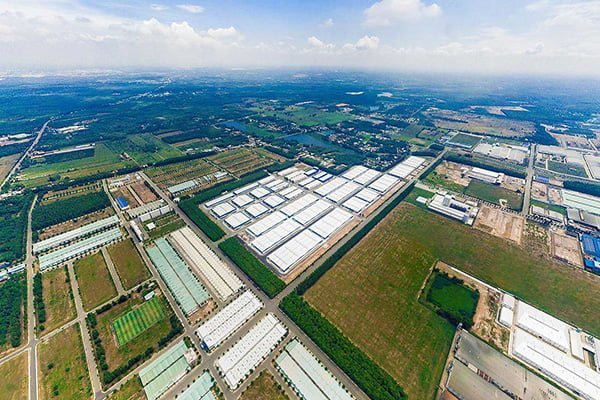Vietnam’s industrial parks (IPs) are central to the nation’s economic development, serving as key drivers of industrialization, growth, and foreign investment. Over recent decades, these well-planned zones have become vital hubs for manufacturing and innovation, contributing significantly to Vietnam’s emergence as one of the world’s fastest growing economies.
IPs are developed and run by both the government and private sector, with the latter dominating the market. As of 2022, Vietnam boasts a total of 563 IPs distributed across 61 out of its 63 provinces. Among these, 397 IPs have been established, with 106 IPs in various stages of construction. The Vietnamese Real Estate Report for 2022 reveals that 292 IPs are fully operational, indicating a robust infrastructure for industrial development.
Each active IP is equipped with dedicated utility infrastructure, including reliable electricity, water supply, and wastewater treatment facilities meeting industry standards. Additionally, these parks offer a range of auxiliary services essential for investors’ manufacturing and business operations, such as banking and logistics support. Many IPs also boast a comprehensive surrounding social infrastructure, comprising amenities like social housing, schools, supermarkets, and hospitals, strategically designed to attract and support a skilled labor force.
Northern Key Economic Region
Encompassing seven provinces, namely Hanoi, Hai Phong, Quang Ninh, Vinh Phuc, Bac Ninh, Hai Dong, and Hung Yen, the Northern Key Economic Region (NKER) stands as a pivotal economic hub in the northern part of Vietnam. Positioned in close proximity to China, it serves as a prime choice within the China+1 strategy. It is estimated that over 18% of Vietnam’s IPs are located in this region.
IPs within the NKER form a dynamic cluster hosting a diverse array of manufacturing industries, including heavyweights like Hoa Phat steel corporation, General Electric, and renowned electronics giants such as Samsung, LG, Canon, Foxconn, Pegatron, along with their extensive supplier networks. The average occupancy rate in 2023 stood at 86.2%, with an average rent of US$120/sqm/lease term, as reported by CBRE.
Northern Central Region
The Northern Central Region, including provinces like Nghe An, Thanh Hoa and Ha Tinh, is a tier- 2 market witnessing increasing absorption, suggesting a rising demand of industrial real estate properties within this region. Abundant labor supply at lower costs makes it an attractive destination for electronics companies like Luxshare-ICT, Goertek, Ju Teng, Foxconn, and Everwin Precision. This region offers a competitive advantage for industries seeking to optimize production costs.
Central Key Economic Region
Covering provinces like Thua Thien Hue, Da Nang, Quang Nam, Quang Ngai, and Binh Dinh, the Central Key Economic Region traditionally hosts key industries such as food processing, textiles, building materials, and paper and forest products. In recent years, Da Nang has emerged as a hub for high-tech and clean industries, offering opportunities for companies aiming to leverage advanced technologies at a more affordable cost. The average rent in this region stands at US$65/sqm/lease term (CBRE).
Southern Key Economic Region
The Southern Key Economic Region, covering Ho Chi Minh City, Binh Duong, Ba Ria – Vung Tau, Dong Nai, Long An, and Tay Ninh provinces, serves as a powerhouse for high-tech and light industries. The region currently hosts the largest number of IPs in Vietnam, accounting for over 28% of total parks across the country. Notably, Saigon High-tech Park is home to high-tech giants like Intel, Nidec, Jabil, Nipro, Samsung, among others, alongside consumer and light industry giants like Coca-Cola, P&G, Nestle, Nike, Adidas, Lego, Pandora, and more located in other IPs.
This region’s strategic importance lies in its role as a hub for high-tech companies, R&D centers, and businesses aiming to diversify their supply chain and distribution network targeting the domestic market. With an average occupancy rate of 85.8% in 2023 (Savills) and an asking rent of US$166/sqm/lease term (CBRE), it remains a premier destination for investors seeking to tap into Vietnam’s vibrant market.
Development outlook
Vietnam’s IPs continue to offer foreign investors a distinct advantage, leveraging not only their strategic location and well-developed infrastructure but also a host of enticing investment incentives. Currently, investment in IPs enjoys great support by the Vietnamese government, including Corporate Income Tax (CIT) incentives (preferential rates and tax holidays), import tax exemptions, beneficial land rent policies, and accelerated depreciation.
Considering a relatively high occupancy rate, Vietnam is focusing on expanding its IPs network, while shifting towards eco-friendly parks, to ensure high-quality and sustainable infrastructure for foreign investment endeavors. Between 2015 and 2019, Vietnam’s Ministry of Planning and Investment (MPI), in partnership with the United Nations Industrial Development Organization (UNIDO) and other sponsors, piloted eco-industrial park models in Ninh Binh, Da Nang, and Can Tho. Over 72 businesses implemented more than 900 resource-efficient and cleaner production solutions, saving US$3.1 million annually and reducing CO2 emissions by 32 kilotons per year. In the period of 2020-2030, the Vietnamese government and UNIDO continue supporting the transformation of industrial parks in Ho Chi Minh City, Hai Phong, and Dong Nai into eco-friendly zones.



